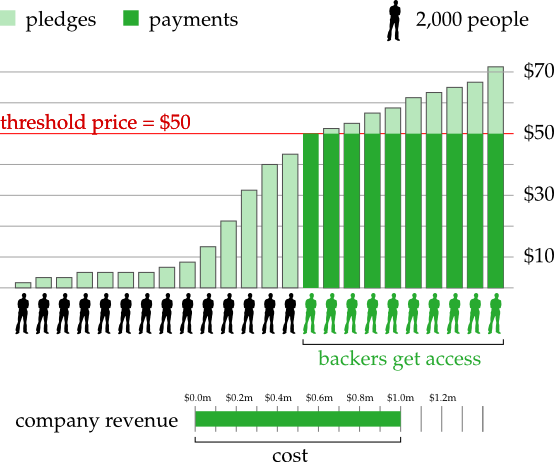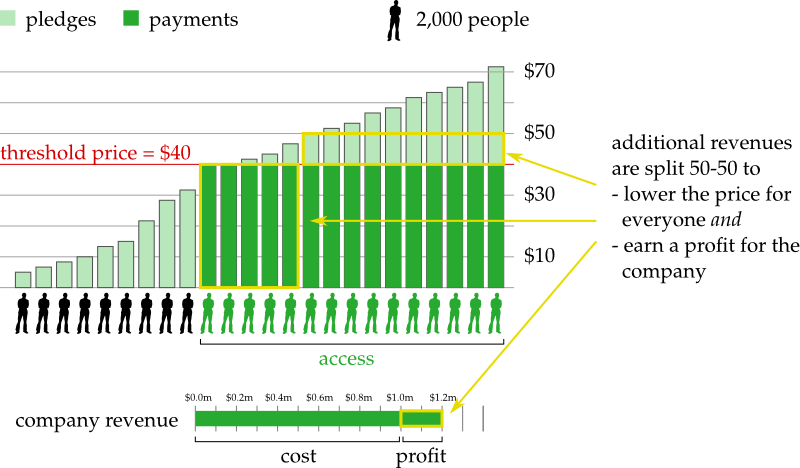We live in a wonderful age! So much that we value - music, movies, books, games, software, designs, research, art, ideas - can be stored in digital form. Once these digital goods are created, they could in principle be made available to everyone at virtually no extra cost. So why don't we? Why do we fight about copyright instead?
The reason is a conflict of economic interests. On the one hand we need to fund the creation of digital goods. On the other hand, our creation can do the most good if it is made available to literally everyone. But how can we convince people to pay for a digital good, if they know that eventually everybody can download a copy for free? What we need is a new idea that addresses both of these issues: the public welfare and the profitability of creating digital goods.
In this regard crowdfunding platforms are very promising, as they can in principle be used to fund digital goods that are then made freely available to everybody. However, a closer look reveals that in practice the digital goods financed by crowdfunding campaigns are often sold like apples - as if they could not be copied at all. Here is one idea how we can do better:
The Average Cost Threshold Protocol is a fair crowdfunding mechanism that takes economic interests of both users and creators into account.
How it works is best explained by way of a concrete example. Suppose a company wants to raise \$1,000,000 to finance the production of a computer game. They start a crowdfunding campaign on a website implementing the Average Cost Threshold Protocol. The website starts collecting pledges until a deadline is reached. Suppose on the day of the deadline the pledge look as in picture below. In particular, we find that there are 20,000 people who pledged \$50 each or more. If all of them pay exactly \$50, then the company's costs will be covered and everybody will have paid the same amount. Moreover \$50 is the lowest price that covers costs: for example 24,000 people would be willing to pay \$40, but that yields only \$960,000. This lowest price now becomes the threshold price: everybody who pledged at least \$50 pays exactly \$50 and they become backers, who will receive a copy of the game once it is finished. All others do not pay anything and do not get a copy. The principle is simple: the costs of production are distributed equally among all those who get access. The threshold price is chosen such that it provides access to the largest number of people at the lowest possible price such that the costs of production are covered.

Now that the game is released, more people have heard about it and want to purchase access. Typically, the company would simply sell copies and keep the revenues as profit. But here comes the twist! Instead of paying a fixed price, interested buyers submit pledges on what they would be willing to pay for the game. Suppose there are another 10,000 people who each pledge \$40 or more. Then we drop the price to \$40 dollars and charge each newcomer \$40 for a copy of the game. The revenues of \$400,000 are split 50-50. One half goes as profit to the company. The other half goes to the original backers, who each get a refund of \$10. Following this principle the price keeps dropping the more people buy the game and thanks to the refunds everybody who gets access is guaranteed to pay the same price no matter how much they pledge or when they pledge.

The more people buy the game, the lower the price for everyone. And the lower the price, the more people can afford to buy the game! What if this virtuous cycle takes off and the game becomes really popular? At this point another feature of the mechanism kicks in: At the very beginning of the crowdfunding campaign a price of freedom of \$10 is announced. This means that as soon as the threshold price drops to the price of freedom of \$10, the game is made available to everyone, the whole world, no matter if they paid or not. This includes the release of the game under a copyleft license as well as the publication of all source code and assets, to allow people to freely modify the game. In the example, the price of freedom of \$10 is reached if the game becomes so popular that at least 180,000 people buy the game. In this scenario, the company has not only covered its costs, but on top of that it also made a profit of \$800,000. (This amounts to an infinite (!) return on investment as the customers contributed all the funding for the project!) The public gains a game they are free to use and modify. And the backers and buyers of the project spent only \$10 each, both to gain early access to the game and to make all of this happen.

We can even go one step further and allow every customer to set their own price of freedom, that is, the price below which they do not care to receive refunds. With this small modification, it is entirely rational for people to pledge exactly as much as they are really willing to pay for the game. This is a truly amazing property that most other methods of raising funds do not satisfy. In a retail sales context, on Kickstarter, in you-name-your-price mechanisms like the Humble Bundle, customers always have an incentive to understate how much the product is worth to them. Here, even entirely self-interested customers have an incentive to tell the truth, at every point during the process. This is not the end of the story, though! The Average Cost Threshold Protocol has a host of variations and wonderful theoretical properties.
As you can see, there is a lot of room to improve upon existing methods for funding digital goods. In a world where digital goods make up an ever increasing percentage of the global economic output this can have a profound impact on our economic lives. With new ideas and experiments we can come up with business models that can raise large amounts of money to finance the creation of high-quality digital goods and at the same time make sure that as many people as possible get access. In particular, we can provide a clear path towards releasing digital goods under a copyleft license. This way, everybody can benefit from the economic power of copying!